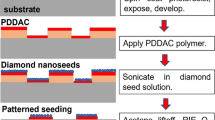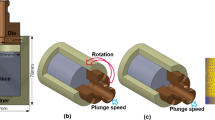Abstract
A finite element model is developed to investigate technical issues associated with hot nanoindentation measurements in vacuum, e.g. thermal expansion-induced drift and temperature variations at the contact region between the cold indenter tip and hot specimen. With heat conduction properly accounted for, the model is able to reasonably reproduce experimental indentation measurements on fused silica and copper—two materials with significantly different thermal and mechanical properties—at several temperatures. Temperature and loading rate effects on thermal drift are established using this model and an analytical expression for predicting thermal drift is numerically calibrated. The model also captures details of the indentation process that are not directly accessible experimentally, and reaffirms the need for operational refinements in order to acquire high temperature indentation data of high quality, especially in a vacuum environment. Such information can guide experiments aimed at understanding thermally-activated phenomena in materials.








Similar content being viewed by others
References
Smith JF, Zheng S (2000) High temperature nanoscale mechanical property measurements. Sur Eng 16:143–146. doi:10.1179/026708400101517044
Wolf B, Bambauer KO, Paufler P (2001) On the temperature dependence of the hardness of quasicrystals. Mater Sci Eng, A 298:284–295. doi:10.1016/S0921-5093(00)01287-9
Kramer DE, Yoder KB, Gerberich WW (2001) Surface constrained plasticity: oxide rupture and the yield point process. Philos Mag A 81:2033–2058. doi:10.1080/01418610108216651
Kraft O, Saxa D, Haag M, Wanner A (2001) The effect of temperature and strain rate on the hardness of Al and Al-based foams as measured by nanoindentation. Z Metallkd 92:1068–1073
Beake BD, Smith JF (2002) High-temperature nanoindentation testing of fused silica and other materials. Philos Mag A 82:2179–2186. doi:10.1080/01418610210134387
Beake BD, Goodes SR, Smith JF (2003) Nanoscale materials testing under industrially relevant conditions: high-temperature nanoindentation testing. Z Metallkd 94:798–801
Xia J, Li CX, Dong H (2003) Hot-stage nano-characterizations of an iron aluminide. Mater Sci Eng, A 354:112–120. doi:10.1016/S0921-5093(02)00902-4
Volinsky AA, Moody NR, Gerberich WW (2004) Nanoindentation of Au and Pt/Cu thin films at elevated temperatures. J Mater Res 19:2650–1657. doi:10.1557/JMR.2004.0331
Hinz M, Kleiner A, Hild S, Marti O, Gotsmann, Durig B, Drechsler U, Albrecht TR, Vettiger P (2004) Temperature dependent nano indentation of thin polymer films with the scanning force microscope. Eur Polym J 40:957–964. doi:10.1016/j.eurpolymj.2004.01.027
Schuh CA, Packard CE, Lund AC (2006) Nanoindentation and contact-mode imaging at high temperatures. J Mater Res 21:725–736. doi:10.1557/JMR.2006.0080
Trenkle JC, Packard CE, Schuh CA (2010) Hot nanoindentation in inert environments. Rev Sci Inst 81:073901. doi:10.1063/1.3436633
Franke O, Trenkle JC, Schuh CA (2010) Temperature dependence of the indentation size effect. J Mater Res 25:1225–1229. doi:10.1557/JMR.2010.0159
Rajulapati KV, Biener MM, Biener J, Hodge AM (2010) Temperature dependence of the plastic flow behavior of tantalum. Philos Mag Lett 90:35–42. doi:10.1080/09500830903356893
Suzuki T, Ohmura T (1996) Ultra-microindentation of silicon at elevated temperatures. Philos Mag A 74:1073–1084. doi:10.1080/01418619608239708
Syed-Asif SA, Pethica JB (1997) Nanoindentation creep of single-crystal tungsten and gallium arsenide. Philos Mag A 76:1105–1118. doi:10.1080/01418619708214217
Lund AC, Hodge AM, Schuh CA (2004) Incipient plasticity during nanoindentation at elevated temperatures. App Phys Lett 85:1362–1364. doi:10.1063/1.1784891
Nieh TG, Iwamoto C, Ikuhara Y, Lee KW, Chung YW (2004) Comparative studies of crystallization of a bulk Zr–Al–Ti–Cu–Ni amorphous alloy. Intermetallics 12:1183–1189. doi:10.1016/j.intermet.2004.04.011
Schuh CA, Mason JK, Lund AC (2005) Quantitative insight into dislocation nucleation from high temperature nanoindentation experiments. Nat Mater 4:617–621. doi:10.1038/nmat1429
Packard CE, Schroers J, Schuh CA (2006) In situ measurements of surface tension-driven shape recovery in metallic glass. Scr Mater 60:1145. doi:10.1016/j.scriptamat.2009.02.056
Sawant A, Tin S (2008) High temperature nanoindentation of a Re-bearing single crystal Ni-base superalloy. Scr Mater 58:275–278. doi:10.1016/j.scriptamat.2007.10.013
Trelewicz JR, Schuh CA (2009) Hot nanoindentation of nanocrystalline Ni-W alloys. Scr Mater 61:1056–1059. doi:10.1016/j.scriptamat.2009.08.026
Bahr DF, Wilson DE, Crowson DA (1999) Energy considerations regarding yield points during indentation. J Mater Res 14:2269–2275. doi:10.1557/JMR.1999.0303
Schuh CA, Lund AC (2004) Application of nucleation theory to the rate dependence of incipient plasticity during nanoindentation. J Mater Res 19:2152–2158. doi:10.1557/JMR.2004.0276
Mason JK, Lund AC, Schuh CA (2006) Determining the activation energy and volume for the onset of plasticity during nanoindentation. Phys Rev B 73:054102. doi:10.1103/PhysRevB.73.054102
Schuh CA, Lund AC, Nieh TG (2004) New regime of homogeneous flow in the deformation map of metallic glasses: Elevated temperature nanoindentation experiments and mechanistic modeling. Acta Mater 52:5879–5891. doi:10.1016/j.actamat.2004.09.005
Packard CE, Schuh CA (2007) Initiation of shear bands near a stress concentration in metallic glass. Acta Mater 55:5348–5358. doi:10.1016/j.actamat.2007.05.054
Jang JI, Lance MJ, Wen SQ, Tsui TY, Pharr GM (2005) Indentation-induced phase transformation in silicon: influences of load, rate and indenter angle on the transformation behavior. Acta Mater 53:1759–1770. doi:10.1016/j.actamat.2004.12.025
Ma XG, Komvopoulos K (2005) In situ transmission electron microscopy and nanoindentation studies of phase transformation and pseudoelasticity of shape-memory titanium-nickel films. J Mater Res 20:1808–1813. doi:10.1557/JMR.2005.0026
Zhang YJ, Cheng YT, Grummon DS (2005) Indentation stress dependence of the temperature range of microscopic superelastic behavior of nickel-titanium thin films. J Appl Phys 98:033505. doi:10.1063/1.1994934
McCormack M, Graebner JE, Tiefel TH, Kammlott GW (1994) Low-temperature thinning of thick chemically vapor-deposited diamond films with a molten Ce-Ni alloy. Diam Relat Mater 3:254–258. doi:10.1016/0925-9635(94)90088-4
Everitt NM, Davies MI, Smith JF (2011) High temperature nanoindenation—the importance of isothermal contact. Philos Mag 91:1221–1244. doi:10.1080/14786435.2010.496745
Bei H, George EP, Hay JL, Pharr GM (2005) Influence of indenter tip geometry on elastic deformation during nanoindenation. Phys Rev Lett 95:045501. doi:10.1103/PhysRevLett.95.045501
Ma D, Ong CW, Wong SF, He J (2005) New method for determining Young’s modulus by non-ideally sharp indentation. J Mater Res 20:1498–1506. doi:10.1557/JMR.2005.0193
Fischer-Cripps AC (2003) Elastic recovery and reloading of hardness impressions with a conical indenter. Mat Res Soc Symp Proc 750:513–518
Tabor D (1951) The hardness of metals. Clarendon, Oxford
Perriot A, Vandembroucq D, Barthel E (2006) Raman microspectroscopic characterization of amorphous silica plastic behavior. J Am Ceram Soc 89:596–601. doi:10.1111/j.1551-2916.2005.00747.x
Carreker RP Jr, Hibbard WR Jr (1953) Tensile deformation of high-purity copper as a function of temperature, strain rate, and grain size. Acta Metall 1:654–663
Durst K, Backes B, Göken M (2005) Indentation size effect in metallic materials: correcting for the size of the plastic zone. Scr Mater 52:1093–1097. doi:10.1016/j.scriptamat.2005.02.009
Farrissey LM, Mchugh PE (2005) Determination of elastic and plastic material properties using indentation: Development of method and application to a thin surface coating. Mater Sci Eng, A 399:254–266. doi:10.1016/j.msea.2005.03.109
Chicot D (2009) Hardness length-scale factor to model nano- and micro-indentation size effect. Mater Sci Eng, A 499:454–461. doi:10.1016/j.msea.2008.09.040
Yang FZ, Wornyo E, Gall K, King WP (2008) Thermomechanical formation and recovery of nanoindents in a shape memory polymer studied using a heated tip. Scanning 30:197–202. doi:10.1002/sca.20074
Zhaoyang Y, Xianping L (2010) A preliminary study of micro heat conduction by hot-tip tribological probe microscope. Key Eng Mat 437:374–378. doi:10.4028/www.scientific.net/KEM.437.374
Korte S, Stearn RJ, Wheeler JM, Clegg WJ (2012) High temperature microcompression and nanoindentation in vacuum. J Mater Res 27:167–176. doi:10.1557/jmr.2011.268
CORNING. Technical Data Sheet. New York. http://www.technicalproductsinc.com/pdf/macor.pdf
Leyens C, Peters M (2003) Titanium and titanium alloys: Fundamentals and applications. WILEY-VCH, Weinheim
Szuecs F, Werner M, Sussmann RS, Pickles CSJ, Fecht HJ (1999) Temperature dependence of Young’s modulus and degradation of chemical vapor deposited diamond. J Appl Phys 86:6010–6017. doi:10.1063/1.371648
Carderelli F (2008) Materials handbook: A concise desktop reference. Springer, New York
Heraeus Quarzglas. Base materials. Technical Properties Sheet. http://heraeus-quarzglas.de/media/webmedia_local/downloads/broschrenbm/BaseMaterials_Image_EN.PDF
Meyers MA, Chawla KK (1999) Mechanical behaviors of materials. Prentice-Hall, New Jersey
Lütjering G, Williams JG (2007) Titanium. Springer, Berlin
Incropera FP, Dewitt DP (1996) Fundamentals of heat and mass transfer. Willey, New York
Acknowledgments
This work was supported by the US Army Research Office through the Institute for Solider Nanotechnologies at MIT. This work is also partially supported by the National Research Foundation of Korea Grand funded by the Korean Government (Ministry of Education, Science and Technology) [NRF-2010357-D00003]. The authors would like to thank Jonathan C. Trenkle for the experimental data and helpful discussion.
Author information
Authors and Affiliations
Corresponding author
Rights and permissions
About this article
Cite this article
Lee, H., Chen, Y., Claisse, A. et al. Finite Element Simulation of Hot Nanoindentation in Vacuum. Exp Mech 53, 1201–1211 (2013). https://doi.org/10.1007/s11340-012-9700-7
Received:
Accepted:
Published:
Issue Date:
DOI: https://doi.org/10.1007/s11340-012-9700-7




